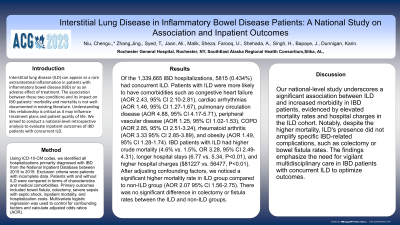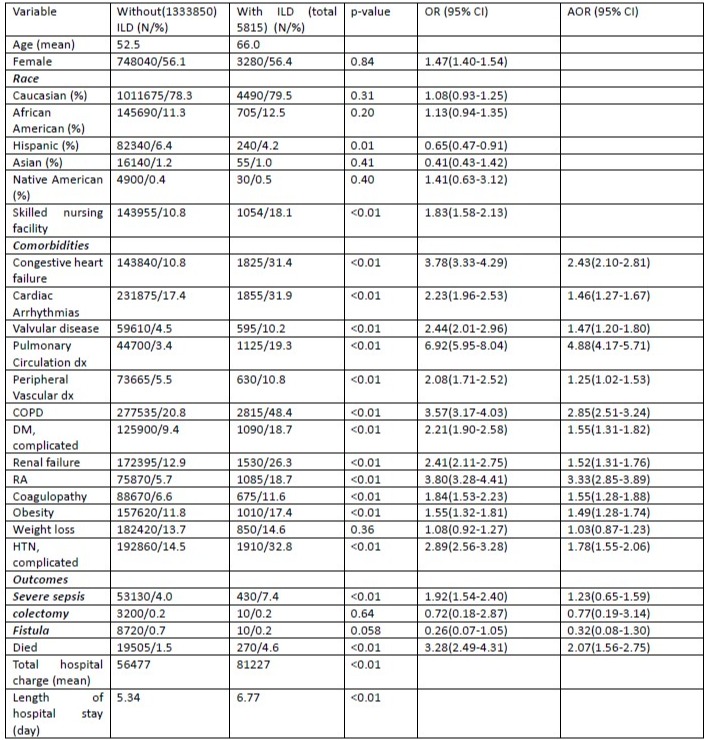Monday Poster Session
Category: IBD
P2182 - Interstitial Lung Disease in Inflammatory Bowel Disease Patients: Insight From National Inpatient Sample Database
Monday, October 23, 2023
10:30 AM - 4:15 PM PT
Location: Exhibit Hall

Has Audio
- CN
Chengu Niu, MD
Rochester General Hospital
Rochester, NY
Presenting Author(s)
Chengu Niu, MD1, Jing Zhang, MD2, Tausif Syed, MD1, Ali Jaan, MD1, Sheza Malik, MD1, Umer Farooq, MD1, Harkarandeep Singh, MD1, Ahmed Shehadah, MD1, Jay Bapaye, MD1, Karin Dunnigan, MD1
1Rochester General Hospital, Rochester, NY; 2Rainier Springs Hospital, Vancouver, WA
Introduction: Interstitial lung disease (ILD) can appear as a rare extraintestinal inflammation in patients with inflammatory bowel disease (IBD) or as an adverse effect of treatment. The association between these two conditions and its impact on IBD patients' morbidity and mortality is not well-documented in existing literature. Understanding this relationship is critical as it may influence treatment plans and patient quality of life. We aimed to conduct a national-level retrospective analysis to evaluate inpatient outcomes of IBD patients with concurrent ILD.
Methods: Using ICD-10-CM codes, we identified all hospitalizations primarily diagnosed with IBD from the National Inpatient Database between 2015 to 2019. Exclusion criteria were patients with incomplete data. Patients with and without ILD were compared in terms of basic characteristics and medical comorbidities. Primary outcomes included bowel fistula, colectomy, severe sepsis with septic shock, inpatient mortality, and hospitalization costs. Multivariate logistic regression was used to control for confounding factors and calculate adjusted odds ratios (AOR).
Results: Of the 1,339,665 IBD hospitalizations, 5815 (0.434%) had concurrent ILD. Patients with ILD were more likely to have comorbidities such as congestive heart failure (AOR 2.43, 95% CI 2.10-2.81), cardiac arrhythmias (AOR 1.46, 95% CI 1.27-1.67), pulmonary circulation disease (AOR 4.88, 95% CI 4.17-5.71), peripheral vascular disease (AOR 1.25, 95% CI 1.02-1.53), COPD (AOR 2.85, 95% CI 2.51-3.24), rheumatoid arthritis (AOR 3.33 95% CI 2.85-3.89), and obesity (AOR 1.49, 95% CI 1.28-1.74). IBD patients with ILD had higher crude mortality (4.6% vs. 1.5%, OR 3.28, 95% CI 2.49-4.31), longer hospital stays (6.77 vs. 5.34, P< 0.01), and higher hospital charges ($81227 vs. 56477, P< 0.01). After adjusting confounding factors, we noticed a significant higher mortality rate in ILD group compared to non-ILD group (AOR 2.07 95% CI 1.56-2.75). There was no significant difference in colectomy or fistula rates between the ILD and non-ILD groups.
Discussion: Those IBD patients with concurrent ILD tend to have more comorbidities, higher mortality, longer lengths of hospital stay, and higher hospital charges during IBD-related hospitalizations. Further research is warranted to better understand the pathophysiological link between ILD and IBD, which could potentially inform targeted treatment strategies and interventions to improve patient outcomes.

Disclosures:
Chengu Niu, MD1, Jing Zhang, MD2, Tausif Syed, MD1, Ali Jaan, MD1, Sheza Malik, MD1, Umer Farooq, MD1, Harkarandeep Singh, MD1, Ahmed Shehadah, MD1, Jay Bapaye, MD1, Karin Dunnigan, MD1. P2182 - Interstitial Lung Disease in Inflammatory Bowel Disease Patients: Insight From National Inpatient Sample Database, ACG 2023 Annual Scientific Meeting Abstracts. Vancouver, BC, Canada: American College of Gastroenterology.
1Rochester General Hospital, Rochester, NY; 2Rainier Springs Hospital, Vancouver, WA
Introduction: Interstitial lung disease (ILD) can appear as a rare extraintestinal inflammation in patients with inflammatory bowel disease (IBD) or as an adverse effect of treatment. The association between these two conditions and its impact on IBD patients' morbidity and mortality is not well-documented in existing literature. Understanding this relationship is critical as it may influence treatment plans and patient quality of life. We aimed to conduct a national-level retrospective analysis to evaluate inpatient outcomes of IBD patients with concurrent ILD.
Methods: Using ICD-10-CM codes, we identified all hospitalizations primarily diagnosed with IBD from the National Inpatient Database between 2015 to 2019. Exclusion criteria were patients with incomplete data. Patients with and without ILD were compared in terms of basic characteristics and medical comorbidities. Primary outcomes included bowel fistula, colectomy, severe sepsis with septic shock, inpatient mortality, and hospitalization costs. Multivariate logistic regression was used to control for confounding factors and calculate adjusted odds ratios (AOR).
Results: Of the 1,339,665 IBD hospitalizations, 5815 (0.434%) had concurrent ILD. Patients with ILD were more likely to have comorbidities such as congestive heart failure (AOR 2.43, 95% CI 2.10-2.81), cardiac arrhythmias (AOR 1.46, 95% CI 1.27-1.67), pulmonary circulation disease (AOR 4.88, 95% CI 4.17-5.71), peripheral vascular disease (AOR 1.25, 95% CI 1.02-1.53), COPD (AOR 2.85, 95% CI 2.51-3.24), rheumatoid arthritis (AOR 3.33 95% CI 2.85-3.89), and obesity (AOR 1.49, 95% CI 1.28-1.74). IBD patients with ILD had higher crude mortality (4.6% vs. 1.5%, OR 3.28, 95% CI 2.49-4.31), longer hospital stays (6.77 vs. 5.34, P< 0.01), and higher hospital charges ($81227 vs. 56477, P< 0.01). After adjusting confounding factors, we noticed a significant higher mortality rate in ILD group compared to non-ILD group (AOR 2.07 95% CI 1.56-2.75). There was no significant difference in colectomy or fistula rates between the ILD and non-ILD groups.
Discussion: Those IBD patients with concurrent ILD tend to have more comorbidities, higher mortality, longer lengths of hospital stay, and higher hospital charges during IBD-related hospitalizations. Further research is warranted to better understand the pathophysiological link between ILD and IBD, which could potentially inform targeted treatment strategies and interventions to improve patient outcomes.

Figure: IBD withith ILD versus with ILD
Disclosures:
Chengu Niu indicated no relevant financial relationships.
Jing Zhang indicated no relevant financial relationships.
Tausif Syed indicated no relevant financial relationships.
Ali Jaan indicated no relevant financial relationships.
Sheza Malik indicated no relevant financial relationships.
Umer Farooq indicated no relevant financial relationships.
Harkarandeep Singh indicated no relevant financial relationships.
Ahmed Shehadah indicated no relevant financial relationships.
Jay Bapaye indicated no relevant financial relationships.
Karin Dunnigan indicated no relevant financial relationships.
Chengu Niu, MD1, Jing Zhang, MD2, Tausif Syed, MD1, Ali Jaan, MD1, Sheza Malik, MD1, Umer Farooq, MD1, Harkarandeep Singh, MD1, Ahmed Shehadah, MD1, Jay Bapaye, MD1, Karin Dunnigan, MD1. P2182 - Interstitial Lung Disease in Inflammatory Bowel Disease Patients: Insight From National Inpatient Sample Database, ACG 2023 Annual Scientific Meeting Abstracts. Vancouver, BC, Canada: American College of Gastroenterology.
